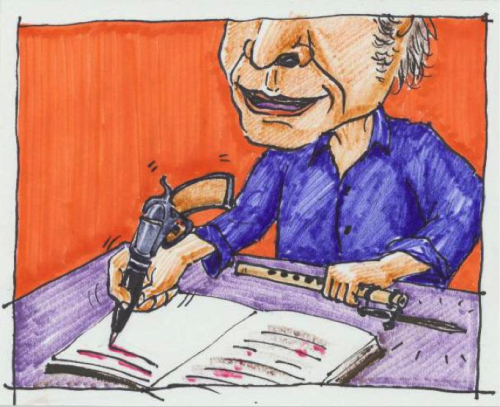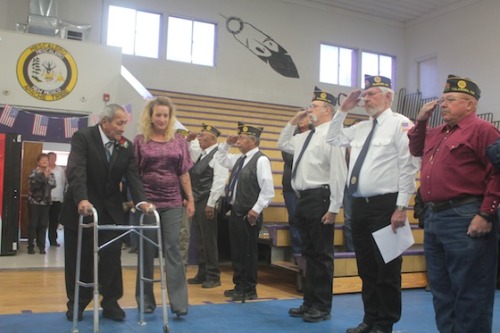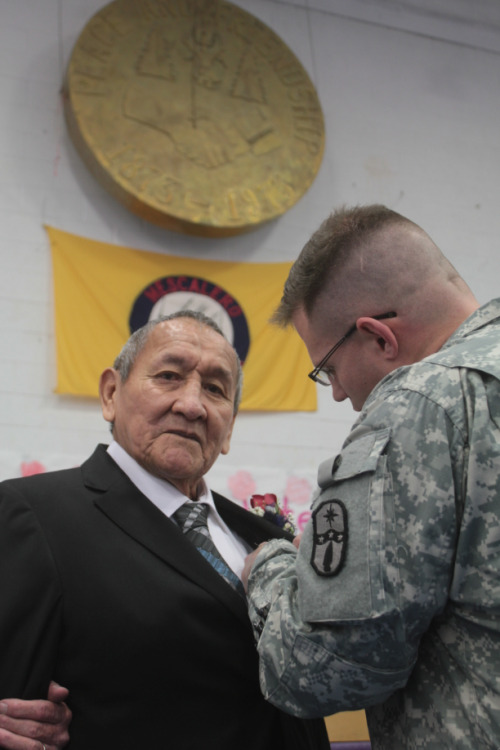#recent news
In the weeks since the Thai military took power in a coup d’etat, poet Krit Lualamai has been responding to upheavals through drawings and poems. Born in Jombeung, in the Ratchaburi province of central Thailand, Lualamai has published one book of poetry, The End of Their, in 2007.
Some of the images, such as “Tank,” satirize the acceptance of the military’s putsch (the eighteenth attempted since 1932). “Mission Impossible!” speaks to the futility of protest felt by some Thai writers and artists. “Flute to cheer on the coup,” and “Big poet,” prod other writers’ support of the Army’s take-over. “Three Figures of Thai Society” chastises the viewer to consider the legacy of these well-known activists and revolutionaries.
Also included here is one of Lualamai’s poems, “Mission to Imagine,” translated by Puckpan Tipayamontri in 2012.
Post link
Forgotten Warrior: Native Vet Waits 41 Years For Medals
Theodore Harvey’s a modest man that lives simply. His bed is properly turned out–crisp sheets are stretched tautly across a single frame without a visible wrinkle, though his hands shake with each querulous movement. His magazines,National Geographics for the most part, lie stacked neatly against the windowsill, next to a shadow box celebrating honors won in Vietnam.
Those honors, simple bits of metal and cloth to the outsider, mean more to Harvey than nearly anything else in the room.
Neither young nor old for his years, Harvey looks all of his 78 hard-lived years–nearly a quarter of them spent fighting, training and waiting on foreign soil.
Harvey was 19 when he enlisted in 1954. He fought–valiantly–for 17 years before he was discharged in 1971.
He then waited 41 years and three days to receive decorations he should have received half a lifetime ago.
Around the tables set up in the Mescalero High School Gymnasium, veterans of different wars–Vietnam and Iraq to name the usual suspects–watched, their individual stories and questions writ large in their expressions and movements.
For the young 1Lt. Daniel Hance, recently returned from the sands, the ceremony was a day of honor, glory and well-deserved recognition. Hance’s eyes shone and his hands were steady as he pinned on the Bronze Star.
For Jerry Ligon, commander of VVA 1062, there was a hint of sorrow as he fastened the Purple Heart, a match for his own medal, on Harvey’s coat.
Theodore Harvey is a Native American veteran that lives quietly in the Mescalero Apache Reservation just outside of Ruidoso, and his story is, unfortunately, far from unique.
Native Americans, percentage-wise, serve in greater frequency in the armed forces than any other ethnicity, according to Department of Defense statistics.
An estimated 12,000 Native Americans stepped up in World War I, with that number rising to about 44,000 soldiers in World War II–roughly 1/8 of the population at the time. About 42,000 willingly marched in to Vietnam, only 10 percent conscripts,according to the Naval History and Heritage website.
There are an estimated 190,000 Native American veterans today, according to the DoD.
Yet recognition for these warriors, as well as other critical benefits, lags behind other veterans, many of whom already are struggling to collect their dues.
Yet Native Americans are only half that lucky, according to a 2011 report from the National Center for Biotechnology Information, “Healthcare Disparities for American Indian Veterans in the United States."
”AIAN (American Indian/Alaskan Native) veterans have 1.9 times higher odds of being uninsured compared with non-Hispanic white veterans,“ the report states. They also are "significantly more likely to delay care due to not getting timely appointments,” they are unlikely to get through on the phone and frequently have transportation problems.
Post link
Crow tribe leases 145 million tons of coal
The new Crow Tract I lease, formalized during a ceremony on Thursday, will mean millions of dollars to the Crow Tribe and a longer life for the Absaroka coal mine. Hundreds of tribal members gathered at the Multipurpose Building in Crow Agency to watch tribal leaders and representatives of Westmoreland Coal Co. sign the documents. The ceremony included speeches, music, prayer and a lunch afterward hosted by Westmoreland for as many as 600 people. Representatives for Sens. Max Baucus and Jon Tester, as well as Rep. Steve Daines also read letters offering their congratulations. Tribal leaders donned ceremonial headdress for the occasion. Intricately beaded items decorated the stage where the speeches and the signing took place. The agreement involves an estimated 145 million more tons of Rosebud McKay coal, located adjacent to the Absaroka mine. The area covers an estimated 14,000 acres in Treasure and Big Horn counties. The lease, subject to approval by the Bureau of Indian Affairs, will allow Westmoreland to control 357 million tons of coal reserves and resources. It is worth $12.5 million in bonus and advance royalty payments to the tribe over the next four and a half years. That’s crucial because a majority of the tribe’s annual operating budget, along with per capita payments to tribal members, come from Westmoreland coal royalties. The agreement also offers hiring and contract preferences for tribal members. Chairman Darrin Old Coyote, who made some of his remarks in Crow, spelled out the details of the lease to his audience. He then asked tribal members who work at the mine to stand up. “The largest percentage of the budget of the Crow Tribe, and the per-cap you get three times a year, comes from the hard work of these gentlemen,” Old Coyote said.
Post link











